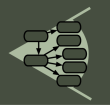| At line 24 added 57 lines. |
| + |
| + SOME MORE SPECIFIC ISSUES TO DISCUSS |
| + |
| + 1) Can (or should) we derive a core set of terms that completely enable the generic description of "scientific observations"? |
| + General enough to enable description of any type of scientific observation |
| + (how does "scientific" constrain our definition of an observation, if at all?) |
| + Should we scope observation to only pertain to some specific types of interests? |
| + Is there a mechanism for specializing/refining descriptions of observation to make "the framework" useful for data integration? |
| + |
| + Are there ways to "add" domain-specific extension to the core definition of an "observation"? |
| + |
| + |
| + 2) Can we establish synonymies and other mappings among terms in the various Observation Models presented so far? |
| + And aside from synonymies, also clarify subsumption (more/less general) and other (part_of, constituted_of) relationships among terms in the various models? Can we identify necessary "components" of the various models for observation (e.g., are space and time information explicitly necessary?); necessary & sufficient (is it sufficient to simply have some measured value of some property of an entity? |
| + |
| + 3) Need unambiguous definitions of Keywords* (currently massive overloading on many of those listed below...) |
| + |
| + Observation |
| + Entities |
| + concrete/theoretical; thing'ish vs process'ish |
| + Attributes/characteristics/features/traits |
| + Procedure/method |
| + Instrument |
| + Measurement |
| + Units |
| + Measurement standards |
| + Specimen/record/collection |
| + Time/duration |
| + Location--point, others |
| + Context/composition/complex types |
| + Transformations/identity |
| + Essential (necessary) features or components |
| + |
| + 4) Is modeling the assertion of some specific ("named") entity type (e.g., rock, crow) best considered as a special form of measurement (attribute type=NAME) |
| + Identifying vs non-identifying names (e.g., Corvus corax vs "Plot A") |
| + presence/absence measurements-- do these need to be treated (ontologically) different from say, measuring mass of a specimen? |
| + names-- are names a special characteristic associated with an entity (a "name" is classifying the entity as some thing) |
| + counts (is a property of set of individuals)-- how does observation model accomodate this type of measurement? |
| + |
| + |
| + 5) Do "where" and "when" information pertain globally and consistently to any type of observation of interest, or are these also types of observations that can provide context for other observations? |
| + |
| + 6) Is there ability within the Observation model, to inter-relate observations to "construct" composite and emergent entities, processes or phenomena? |
| + |
| + 7) How can ontology/model be deployed in terms of real useful applications? Must data be ingested into a framework implementing the model, or can the model(s) be applied to data (e.g., via annotation) |
| + |
| + 8) Is there possibility for multiple interpretations of a given observation? Is this ever necessary or desirable? |
| + |
| + 9) How indicate that parts of tuple are dependent/independent |
| + e.g. enriching context can be optional, but high dependency requires association of two observations ( |
| + |
| + 10) How rich must be set of associations/relations among observations. How specialized can these get? |
| + (wolf fighting mountain lion) |
| + |
| + 11) Is it important to be able to differentiate individual instances vs. generic assertions in a data set ("a wolf fighting a mountain lion" vs "wolves fight mountain lions") |
| + |
| + |








